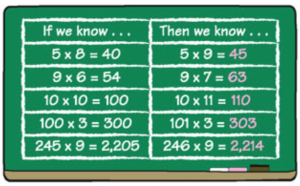“If We Know…”
Purpose
To practice multiplication facts and recognize how facts build on each other
Materials
None
Overview
 In this activity, students use known multiplication facts to generate other multiplication facts. Say to your class, “If we know 6 × 5 is 30, then what is 7 × 5?” A student may reason that if 6 groups of 5 are 30, then 7 groups of 5 must be 5 more, so 7 × 5 is 35.
In this activity, students use known multiplication facts to generate other multiplication facts. Say to your class, “If we know 6 × 5 is 30, then what is 7 × 5?” A student may reason that if 6 groups of 5 are 30, then 7 groups of 5 must be 5 more, so 7 × 5 is 35.
About the sequence
Part 1 focuses on how multiplication facts with factors 5 or less build upon one another. Part 2 offers more practice as students continue to explore how math facts are related as a factor increases by one. The extension focuses on how math facts are related when a factor decreases by one.
Part 1
Let’s explore how multiplication facts build on each other. For example, if 2 groups of 10 equals 20, 3 groups of 10 equals 30. Let’s go!
- If 1 group of 5 equals… (5), then we know 2 groups of 5 equals… (10)
- If 5 groups of 3 equals… (15), then we know 5 groups of 4 equals… (20)
- If 4 groups of 3 equals… (12), then we know 5 groups of 3 equals…(15)
- If 3 groups of 2 equals… (6), then we know 4 groups of 2 equals… (8)
- If 3 groups of 2 equals… (6), then we know 3 groups of 3 equals… (9)
While children are enjoying their building of mastery. Feel free to repeat. When children are eager for more, try Part 2.
Part 2
Let’s see how this next group of facts build on each other…
Examples:
- If we know 6 × 4 equals..(24), then we know 7 × 4 equals… (28)
- If we know 5 × 6 equals…(30) then we know 6 × 6 equals… (36)
- If we know 7 × 7 equals…(49), then we know 8 × 7 equals… (56)
- If we know 6 × 8 equals…(48), then we know 7 × 8 equals… (56)
- If we know 4 × 8 equals…(32), then we know 5 × 8 equals… (40)
- If we know 11 × 7 equals…(77), then we know 12 × 7 equals… (84)
- If we know 100 × 3 equals…(300), then we know 101 × 3 equals… (303)
- If we know 100 × 6 equals…(600), then we know 101 × 6 equals… (606)
- If we know 10 × 20 equals…(200), then we know 11 × 20 equals… (220)
Extension
Let’s see how this next group of facts build on each other…
Examples:
- If 5 groups of 3 equals… (15), then we know 5 groups of 2 equals… (10)
- If 4 groups of 3 equals… (12), then we know 3 groups of 3 equals…(9)
- If we know 6 × 4 equals… (24), then we know 5 x 4 equals… (20)
- If we know 5 × 6 equals… (30), then we know 4 x 6 equal…(24)
- If we know 7 × 7 equals… (49), then we know 6 x 7 equals… (42)
- If we know 6 × 8 equals… (48), then we know 5 x 8 equals … (40)
- If we know 4 × 8 equals… (32), then we know 3 x 8 equals … (24)
- If we know 11 × 7 equals… (77), then we know 10 x 7 equals … (70)

This work is licensed under a
Creative Commons Attribution-NonCommercial-NoDerivatives 4.0 International License.
